Auvers-sur-Oise
Auvers-sur-Oise (French: [ovɛʁ.syʁ.waz] (![]()
Auvers-sur-Oise | |
|---|---|
%2C_ch%C3%A2teau_de_Leyrit%2C_rue_de_L%C3%A9ry.jpg) The Château de Léry, built in the 17th and 18th centuries | |
.svg.png) Coat of arms | |
Location of Auvers-sur-Oise 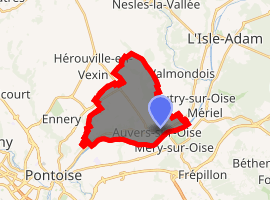
| |
 Auvers-sur-Oise 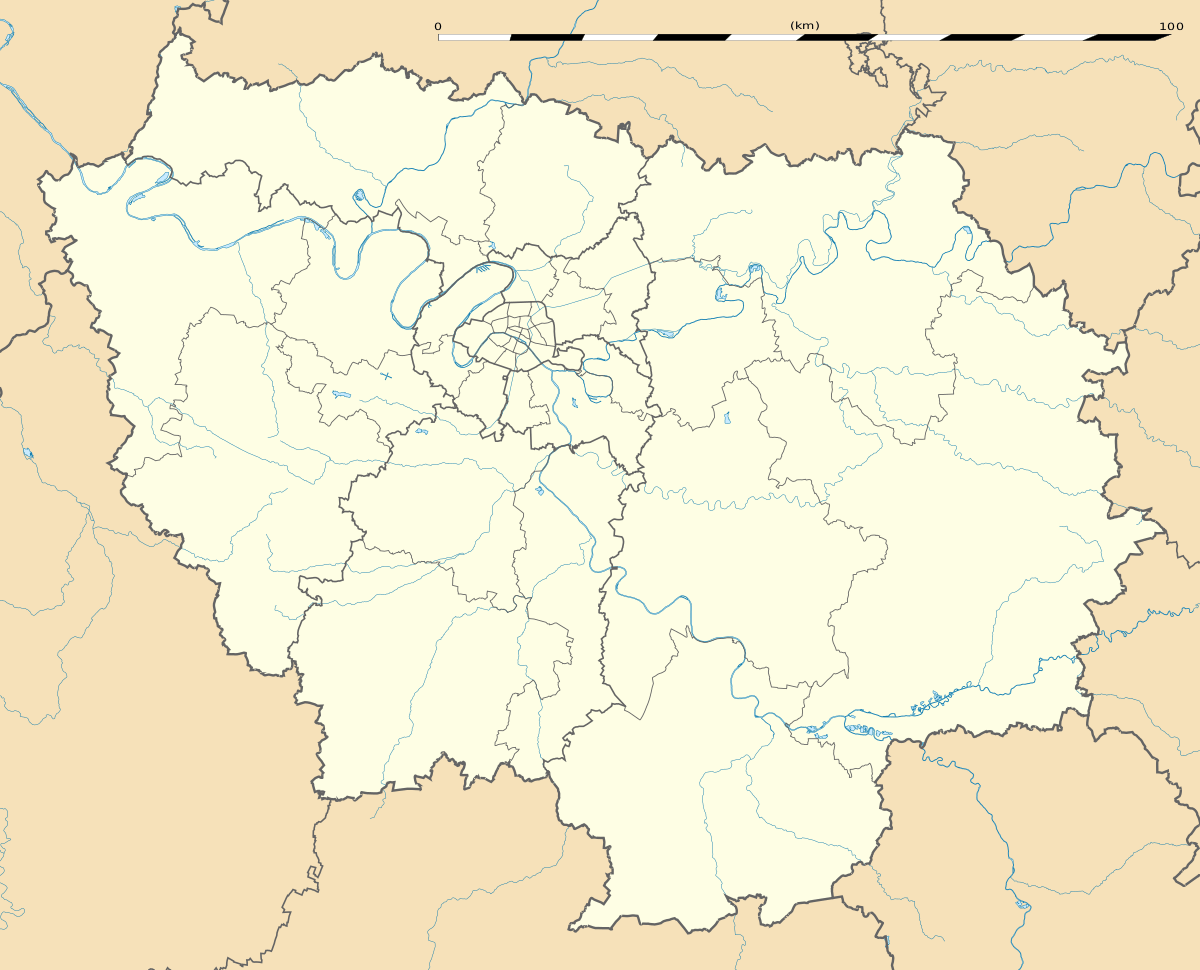 Auvers-sur-Oise | |
| Coordinates: 49°04′21″N 2°10′30″E | |
| Country | France |
| Region | Île-de-France |
| Department | Val-d'Oise |
| Arrondissement | Pontoise |
| Canton | Saint-Ouen-l'Aumône |
| Intercommunality | CC Sausseron Impressionnistes |
| Government | |
| • Mayor (2020-2026) | Isabelle Mézières |
| Area 1 | 12.69 km2 (4.90 sq mi) |
| Population (2017-01-01)[1] | 6,908 |
| • Density | 540/km2 (1,400/sq mi) |
| Time zone | UTC+01:00 (CET) |
| • Summer (DST) | UTC+02:00 (CEST) |
| INSEE/Postal code | 95039 /95430 |
| Elevation | 21–111 m (69–364 ft) |
| 1 French Land Register data, which excludes lakes, ponds, glaciers > 1 km2 (0.386 sq mi or 247 acres) and river estuaries. | |
Geography
Location
Auvers is located in the department Val d'Oise on the right bank of the river Oise. To the south, it is connected to Méry-sur-Oise by a bridge.
Localities
- Chaponval
- Cordeville (from Corbeville)
- Le Montcel (from Monsellus, small mountain)
- Les Vaissenots or Vessenots
- Le Valhermeil (from Val Hermer, name of the owner during the 12th century)
- Les Vallées
History
During the 19th century, a number of painters lived and worked in Auvers-sur-Oise, including Paul Cézanne, Charles-François Daubigny, Camille Pissarro, Jean-Baptiste-Camille Corot, Norbert Goeneutte, and Vincent van Gogh. Daubigny's house is now a museum where one can see paintings by the artist, his family, and friends, such as Honoré Daumier, as well as rooms decorated in period style. Charles Sprague Pearce (1851-1914) died there also. Along the river walk from Auvers toward Pontoise are a number of views which featured in the paintings of Pissarro.
During the 20th century artists continued to frequent Auvers, including Henri Rousseau (Douanier Rousseau), Otto Freundlich and Pierre Daboval. The COBRA artist Corneille spent his last years in the village and is buried a few metres from Vincent van Gogh.[2]
Population
| Year | 1793 | 1800 | 1806 | 1821 | 1831 | 1836 | 1841 | 1846 | 1851 | 1856 |
|---|---|---|---|---|---|---|---|---|---|---|
| Population | 1,754 | 1,635 | 1,708 | 1,705 | 1,806 | 1,522 | 1,530 | 1,547 | 1,553 | 1,574 |
| Year | 1861 | 1866 | 1872 | 1876 | 1881 | 1886 | 1891 | 1896 | 1901 | 1906 |
|---|---|---|---|---|---|---|---|---|---|---|
| Population | 1,648 | 1,635 | 1,720 | 1,638 | 1,713 | 1,936 | 2,063 | 2,255 | 2,402 | 2,544 |
| Year | 1911 | 1921 | 1926 | 1931 | 1936 | 1946 | 1954 | 1962 | 1968 | 1975 |
|---|---|---|---|---|---|---|---|---|---|---|
| Population | 2,681 | 2,961 | 3,132 | 3,240 | 3,163 | 3,345 | 3,172 | 3,772 | 5,124 | 5,808 |
| Year | 1982 | 1990 | 1999 | 2008 | 2014 |
|---|---|---|---|---|---|
| Population | 5,722 | 6,129 | 6,820 | 6,879 | 6,943 |
Administration
On 1 August 1948, 17% of the territory of Auvers-sur-Oise was detached and became the commune of Butry-sur-Oise.
The current mayor is Isabelle Mézières. She was first elected in 2014, and was then re-elected in March 2020.
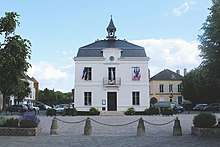
Culture
Monuments
The creation of the church dates back to the 11th century. Louis VI le Gros (1081-1137) owned a manor in Auvers, where he often used to come to hunt. In 1131 his son, Philippe, who was the crown prince, accidentally fell from his horse and died. A chapel was erected for his burial place and this subsequently became the church Notre-Dame de l'Assomptio: in 1915 it was listed as a historic monument. Together with the royal manor, they represent a major historical piece of the heritage of the city, where many famous painters came during the 19th century, such as Daubigny, Bourges, Bernard, Pearce, Bastard, Boggio or Wickenden.
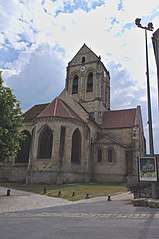 Church Notre-Dame de l'Assomption
Church Notre-Dame de l'Assomption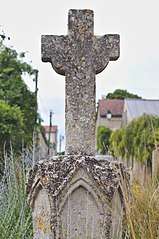 Croix du Montcel
Croix du Montcel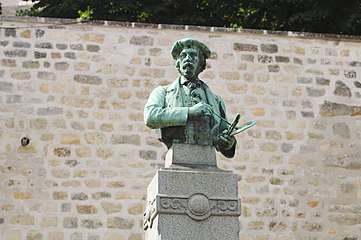 Statue of Charles-François Daubigny
Statue of Charles-François Daubigny
Museums
- The musée Daubigny, located in the Colombières manor, was created in 1986 by the Tourist Office. The museum owns about a hundred works by Daubigny, such as paintings, drawings and engravings. The artist arrived in Auvers in the 1860s and stayed there for 18 years. He had a workshop boat called the "Botin", where he used to paint fluvial landscapes and sailed with his son, Karl. Then, many of his friends also came to Auvers to paint the landcapes. The museum mainly deals with pre-Impressionism. It has been a municipal museum since 2012.
- The musée de l'absinthe (Absinthe museum), located on the street rue Callé, deals with the history of the drink.
Van Gogh
Dr. Paul Gachet lived in Auvers-sur-Oise. He was acquainted with the avant-garde artists of the time. Through this connection, Vincent van Gogh moved to Auvers to be treated by him, though he considered the doctor to be in a worse state than himself. Gachet befriended Van Gogh and was the subject of two portraits, one of which, Portrait of Dr. Gachet, was sold at auction for over $80m (£48m) in 1990.[3]
Van Gogh died from a self-inflicted gunshot wound to the chest. The room on the upper floor of the Auberge Ravoux where he died has been preserved, although no furniture remains. The Institut Van Gogh owns Auberge Ravoux, organizes the visits of Van Gogh's room and has opened a restaurant in the dining room.[4] Auvers-sur-Oise is the final resting place of both Vincent and his brother Theo van Gogh, who died six months later.[3]
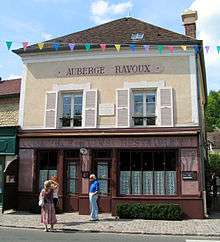 L’Auberge Ravoux, where Vincent van Gogh spent his final months and where he died. It is now a restaurant.
L’Auberge Ravoux, where Vincent van Gogh spent his final months and where he died. It is now a restaurant.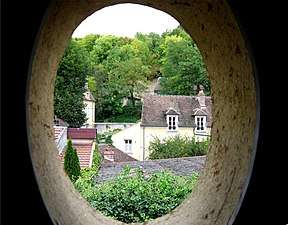 View from the staircase leading up to Van Gogh's room in L'Auberge Ravoux
View from the staircase leading up to Van Gogh's room in L'Auberge Ravoux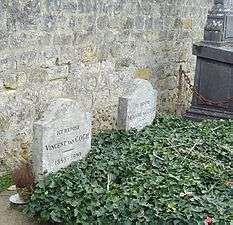 Vincent and Theo van Gogh's graves in Auvers-sur-Oise.
Vincent and Theo van Gogh's graves in Auvers-sur-Oise.
- Auvers-sur-Oise in art
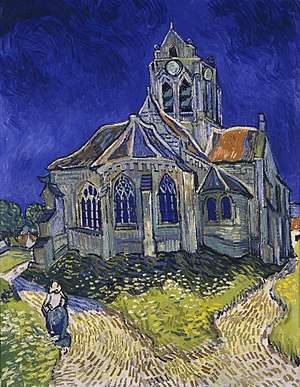
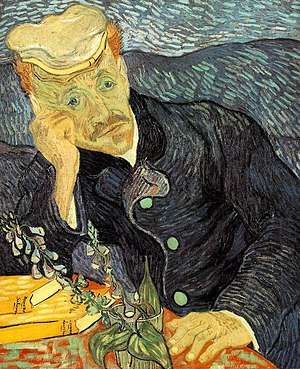 Portrait of Dr. Gachet by Vincent van Gogh
Portrait of Dr. Gachet by Vincent van Gogh_-_Wheat_Field_with_Crows_(1890).jpg) Wheat Field with Crows, one of Van Gogh's last paintings
Wheat Field with Crows, one of Van Gogh's last paintings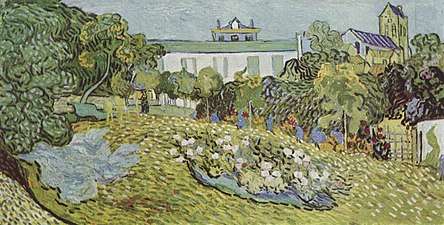 Daubigny's Garden, possibly Van Gogh's final painting
Daubigny's Garden, possibly Van Gogh's final painting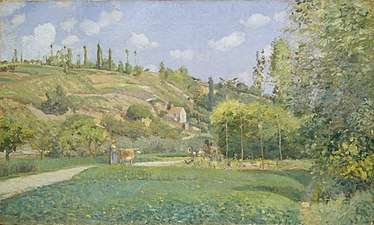 Camille Pissarro,
Camille Pissarro,
A Cowherd at Valhermeil, Auvers-sur-Oise, The Metropolitan Museum of Art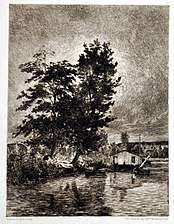 Charles Joseph Beauverie, Auvers-sur-Oise (Bâteau lavoir à Auvers), ca.1870
Charles Joseph Beauverie, Auvers-sur-Oise (Bâteau lavoir à Auvers), ca.1870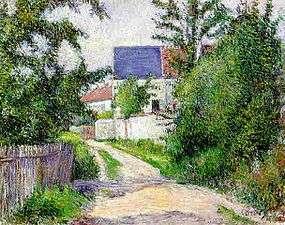 Frédéric Samuel Cordey, Ruelle à Auvers sur Oise, circa 1903
Frédéric Samuel Cordey, Ruelle à Auvers sur Oise, circa 1903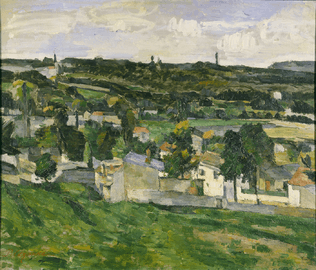 Paul Cézanne, View of Auvers-sur-Oise, 1873–75
Paul Cézanne, View of Auvers-sur-Oise, 1873–75
Transport
Auvers-sur-Oise is served by two stations on the Transilien Paris – Nord suburban rail line: Chaponval and Auvers-sur-Oise. The stations both lie on the line Pontoise-Creil. Between April and October, on Saturdays, Sundays and public holidays, direct trains go from Paris Gare du Nord to Auvers.
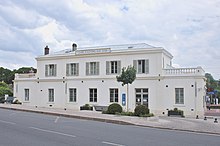
Auvers is also served by two bus lines : 95 07 and 95 17.
References
- "Populations légales 2017". INSEE. Retrieved 6 January 2020.
- "IVincent van Gogh's Grave". Minor Sights. 14 November 2014. Retrieved 2015-02-28.
- Dowd, Vincent (24 October 2009). "In the footsteps of Vincent van Gogh". BBC News. Retrieved 2009-10-25.
- "Van Gogh in Auvers-sur-Oise. Auberge Ravoux visit". Paris Digest. 2020. Retrieved 2020-07-30.
- INSEE
- Association of Mayors of the Val d’Oise (in French)
External links
| Wikimedia Commons has media related to Auvers-sur-Oise. |
- Official website (in French)
- The Complete Works of Vincent van Gogh
- Following Vincent Van Gogh in Auvers-sur-Oise
